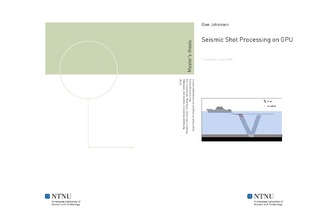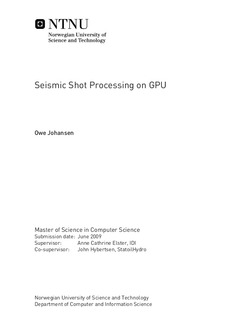| dc.contributor.advisor | Elster, Anne Cathrine | nb_NO |
| dc.contributor.advisor | Hybertsen, John | nb_NO |
| dc.contributor.author | Johansen, Owe | nb_NO |
| dc.date.accessioned | 2014-12-19T13:34:03Z | |
| dc.date.available | 2014-12-19T13:34:03Z | |
| dc.date.created | 2010-09-04 | nb_NO |
| dc.date.issued | 2009 | nb_NO |
| dc.identifier | 348883 | nb_NO |
| dc.identifier | ntnudaim:4677 | nb_NO |
| dc.identifier.uri | http://hdl.handle.net/11250/251391 | |
| dc.description.abstract | Today s petroleum industry demand an ever increasing amount of compu- tational resources. Seismic processing applications in use by these types of companies have generally been using large clusters of compute nodes, whose only computing resource has been the CPU. However, using Graphics Pro- cessing Units (GPU) for general purpose programming is these days becoming increasingly more popular in the high performance computing area. In 2007, NVIDIA corporation launched their framework for developing GPU utilizing computational algorithms, known as the Compute Unied Device Architec- ture (CUDA), a wide variety of research areas have adopted this framework for their algorithms. This thesis looks at the applicability of GPU techniques and CUDA for off-loading some of the computational workload in a seismic shot modeling application provided by StatoilHydro to modern GPUs. This work builds on our recent project that looked at providing check- point restart for this MPI enabled shot modeling application. In this thesis, we demonstrate that the inherent data parallelism in the core finite-difference computations also makes our application well suited for GPU acceleration. By using CUDA, we show that we could do an efficient port our application, and through further refinements achieve significant performance increases. Benchmarks done on two different systems in the NTNU IDI (Depart- ment of Computer and Information Science) HPC-lab, are included. One system is a Intel Core2 Quad Q9550 @2.83GHz with 4GB of RAM and an NVIDIA GeForce GTX280 and NVIDIA Tesla C1060 GPU. Our sec- ond testbed was an Intel Core I7 Extreme (965 @3.20GHz) with 12GB of RAM hosting an NVIDIA Tesla S1070 (4X NVIDIA Tesla C1060). On this hardware, speedups up to a factor of 8-14.79 compared to the original se- quential code are achieved, confirming the potential of GPU computing in applications similar to the one used in this thesis. | nb_NO |
| dc.language | eng | nb_NO |
| dc.publisher | Institutt for datateknikk og informasjonsvitenskap | nb_NO |
| dc.subject | ntnudaim | no_NO |
| dc.subject | SIF2 datateknikk | no_NO |
| dc.subject | Komplekse datasystemer | no_NO |
| dc.title | Seismic Shot Processing on GPU | nb_NO |
| dc.type | Master thesis | nb_NO |
| dc.source.pagenumber | 56 | nb_NO |
| dc.contributor.department | Norges teknisk-naturvitenskapelige universitet, Fakultet for informasjonsteknologi, matematikk og elektroteknikk, Institutt for datateknikk og informasjonsvitenskap | nb_NO |

